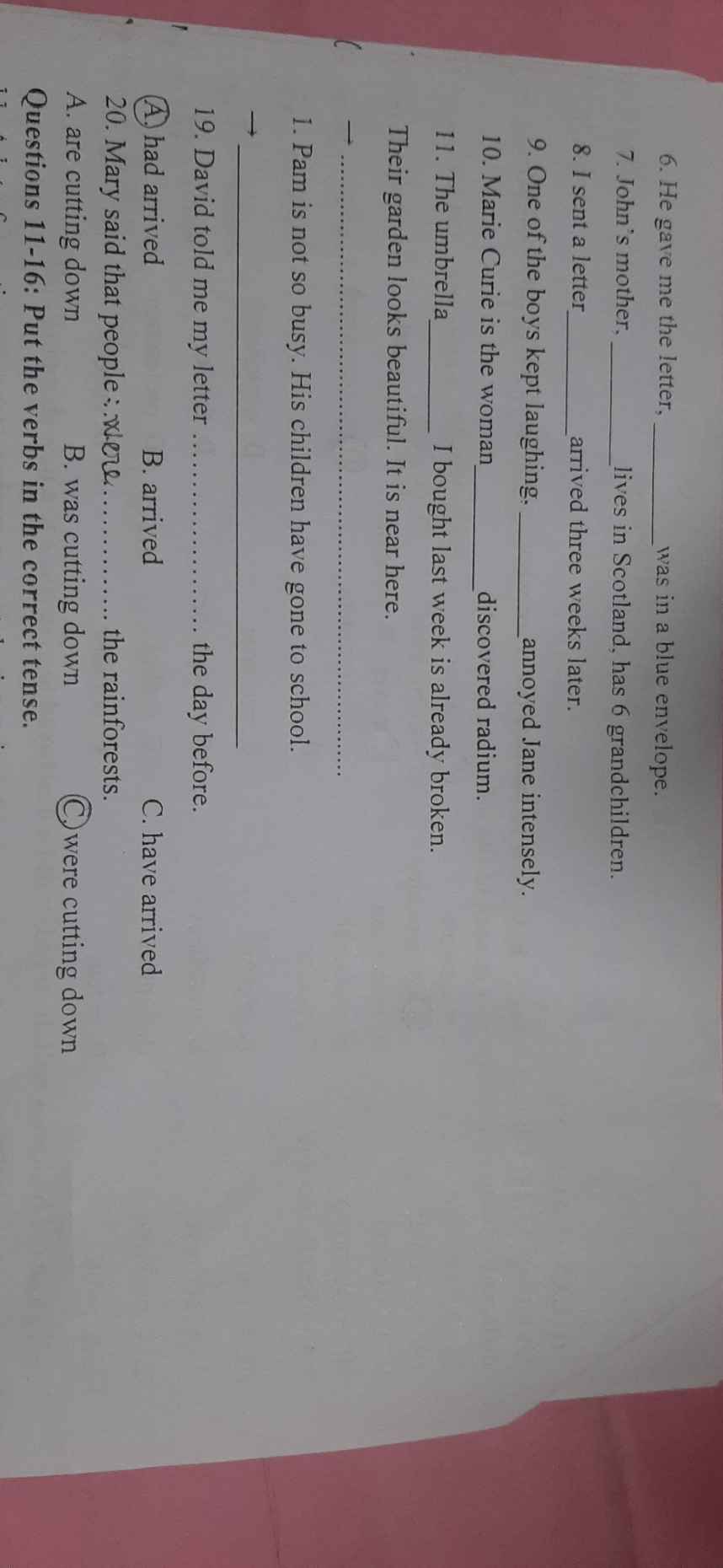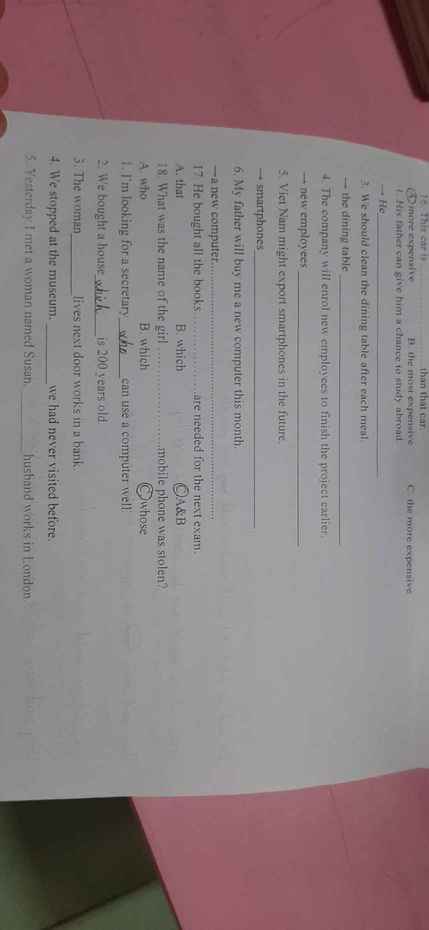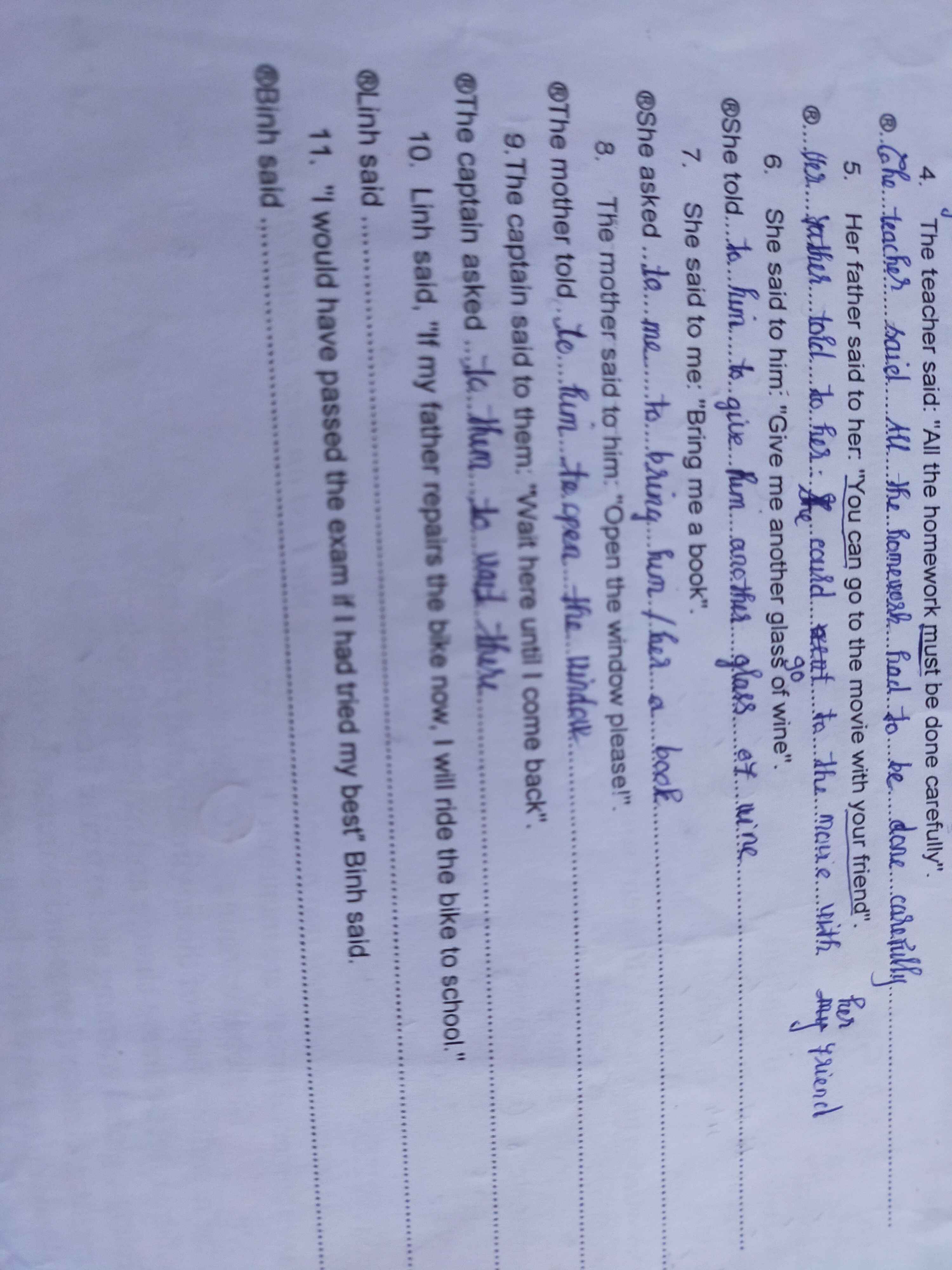Làm giúp mình câu 6 đến 1 ở hình 1 với nha
Tony said he ... The accident at the comer of the street.
A. Sees B. Will see C. Had seen D. Has seen
Bob said they ... a wonderful time at Peter's party.
A. Have B. Had had C. Will have D. Have had
Chọn giúp mình 2 đáp án
Làm 1 đến 7 ở hình 2 giúp mình nha mai thi rùi


Đề kiểm tra học kì
Làm giúp mình câu 9 đến 4 ở hình 1
Câu 1 đến 5 yesterday. Ở hình 2

do you know the solar system Please help me with an article about the stars and planets in the solar system!
Do you know? Solar System or Solar System is a planetary system with the Sun in the center and celestial bodies within the range of the Sun's gravitational force, all of which are formed from the collapse of a giant molecular cloud. giant nearly 4.6 billion years ago. Most of the celestial bodies orbit the Sun, and the mass is concentrated mainly on eight planets with nearly circular orbits and closely matched orbital planes called the ecliptic plane. 4 small planets in the ring include: Mercury, Venus, Earth and Mars. The four outer gas giants have a much greater mass than the four inner ring planets. The 2 largest planets, Jupiter and Saturn and the 2 outermost planets, Uranus and Neptune.
The Sun is the most prominent and central star in the Solar System that produces temperatures and densities large enough at the core for nuclear fusion to release enormous amounts of energy. The Sun is again a large, bright star that shows its luminosity to its surface temperature. In general, the brighter stars are hotter. The Sun is to the right of the middle segment of a band called the main band on the chart. It is believed that with the Sun's position on the main band this is a star in "intense life", which has yet to run out of hydrogen fuel for nuclear fusion.
So what is in the inner circle of the solar system? It includes the planets closest to the Sun - the largest star in the Solar System. And Mercury - the closest planet to the Sun and the smallest planet in the Solar System. That is why Mercury ends a year for every 88 days in the Earth's calendar, which is a circle of the Sun. Mercury has no natural satellites, and it only has geological features besides the craters, the slopes and cliffs, probably formed during the first contraction period in its history.
Next is the second planet of the Solar System, Venus. Venus is named after the god of love and beauty in Greek mythology. Venus is often referred to as a sister planet to Earth because of its mass, size and structural characteristics. Venus has a thick atmosphere and there is evidence that the planet has geological activity within it.
So what is the third planet? You will probably know! Yes, that's where we live - our planet - Earth. And the only planet we know of that has more recent geological activity, the only planet so far believed to have any kind of life. Earth is also the only planet among the planets in the English solar system that is not named after any Greek deity.
Finally, in the inner belt Mars is also known as the "red planet" because the surface is covered with a red color. Mars is the fourth planet from the center of the Solar System and owns the highest mountain named Olympus Mons with a height of 21 km and a diameter of 600 km. The planet's highest temperature can only reach 20 degrees and can sometimes as low as minus 153 degrees.
Besides the inner ring, we also know the outer ring of the Solar System. Jupiter - the 5th largest planet in the solar system, Jupiter owns the record for the shortest time per day, with a length of 9 hours 55 minutes Earth time. That is, every 9:55 minutes, it ends a rotation around its own axis.
The sixth planet is from the sun and is famous for its ring - Saturn. This circle is made up of dust and rocks about 20 meters thick and more than 120 thousand kilometers from this planet. Jupiter is also the most easily visible planet to the naked eye.
Uranus, the seventh planet in the Solar System and the lowest in temperature, can fall below minus 224 degrees Celsius. So far, there has been only one spacecraft flying past Uranus this year. 1986 is called Voyager 2, bringing back a wealth of information about the planet as well as its moons and circles. And at the very end of the outer ring is the farthest planet in the solar system, Neptune. That is why it is the planet with the lowest average temperature of any planet. In 1989, it was the Voyager 2 that flew over the planet and sent back countless pictures of it.
In addition, there are many asteroids that we are not fully aware of. Those are the stars that sparkle in the night sky that we watch as night falls. The Milky Way is so huge, is there a day we can explore it? Hopefully it becomes a reality so that someday in the future we can set foot on the distant stars in the vast Solar System on our own.
Đúng 1
Bình luận (0)
Bản dịch:
Bạn có biết không? Hệ Mặt Trời hay Thái Dương Hệ là 1 hệ hành tinh có Mặt Trời ở trung tâm và các thiên thể nằm trong phạm vi lực hấp dẫn của Mặt Trời, tất cả chúng được hình thành từ sự suy sụp của 1 đám mây phân tử khổng lồ cách đây gần 4,6 tỷ năm. Đa phần các thiên thể quay quanh Mặt Trời, và khối lượng tập trung chủ yếu vào 8 hành tinh có quỹ đạo gần tròn và mặt phẳng quỹ đạo gần trùng khít với nhau gọi là mặt phẳng hoàng đạo. 4 hành tinh nhỏ vòng trong gồm: Sao Thủy, Sao Kim, Trái Đất và Sao Hỏa. 4 hành tinh khí khổng lồ vòng ngoài có khối lượng lớn hơn rất nhiều so với 4 hành tinh vòng trong. 2 hành tinh lớn nhất, Sao Mộc và Sao Thổ và 2 hành tinh nằm ngoài cùng, Sao Thiên Vương và Sao Hải Vương.
Mặt Trời là ngôi sao ở trung tâm và nổi bật nhất trong Thái Dương Hệ tạo ra nhiệt độ và mật độ đủ lớn tại lõi để xảy ra phản ứng tổng hợp hạt nhân làm giải phóng 1 lượng năng lượng khổng lồ. Mặt Trời lại là 1 ngôi sao lớn và sáng thể hiện độ sáng của sao với nhiệt độ bề mặt của nó. Nói chung, các sao sáng hơn thì nóng hơn. Mặt Trời nằm ở bên phải của đoạn giữa 1 dải gọi là dải chính trên biểu đồ. Người ta tin rằng với vị trí của Mặt Trời trên dải chính như vậy thì đây là một ngôi sao đang trong "cuộc sống mãnh liệt", nó vẫn chưa bị cạn kiệt nguồn nhiên liệu hiđrô cho các phản ứng tổng hợp hạt nhân.
Vậy ở vòng trong của hệ mặt trời có gì? Nó bao gồm các hành tinh ở gần Mặt Trời nhất - ngôi sao lớn nhất của Thái Dương Hệ. Và Sao Thủy - hành tinh gần Mặt Trời nhất và là hành tinh nhỏ nhất trong Hệ Mặt Trời. Vì thế mà cứ 88 ngày theo lịch trái đất thì Sao Thuỷ đã kết thúc một năm, tức là một vòng quanh Mặt Trời. Sao Thủy không có vệ tinh tự nhiên, và nó chỉ có các đặc trưng địa chất bên cạnh các hố va chạm đó là các sườn và vách núi, có lẽ được hình thành trong giai đoạn co lại đầu tiên trong lịch sử của nó.
Tiếp đến là hành tinh thứ hai của Hệ Mặt Trời, Sao Kim. Sao Kim được đặt tên theo vị thần tình yêu và sắc đẹp trong thần thoại Hy Lạp. Venus thường được gọi là hành tinh chị em với Trái Đất bởi khối lượng, kích thước và đặc điểm cấu tạo giống Trái Đất. Sao Kim có 1 bầu khí quyển dày và có những chứng cứ cho thấy hành tinh này còn sự hoạt động của địa chất bên trong nó.
Vậy hành tinh thứ ba là gì? Có lẽ bạn sẽ biết đấy! Phải, đó là nơi chúng ta sinh sống - hành tinh của chúng ta - Trái Đất. Và là hành tinh duy nhất chúng ta biết còn có các hoạt động địa chất như gần đây, hành tinh duy nhất cho đến nay được cho là có tồn tại sự sống. Trái Đất cũng là hành tinh duy nhất trong số các hành tinh trong hệ mặt trời bằng tiếng Anh không được đặt tên theo bất kì một vị thần nào trong thần thoại Hy Lạp.
Cuối cùng, trong vành đai trong là Sao Hoả còn được gọi với cái tên khác là “hành tinh đỏ” bởi bề mặt được bao phủ bằng một màu đỏ của nó. Sao Hoả là hành tinh đứng thứ 4 tính từ trung tâm Hệ Mặt Trời và sở hữu cho mình ngọn núi cao nhất mang tên Olympus Mons với chiều cao 21 km và đường kính rộng 600 km. Nhiệt độ cao nhất của hành tinh này chỉ có thể đạt tới 20 độ và đôi khi có thể xuống mức thấp nhất tới âm 153 độ.
Ngoài vòng trong ra, ta còn biết vòng ngoài của Hệ Mặt Trời. Sao Mộc - hành tinh đứng thứ 5 trong hệ mặt Trời, sao mộc sở hữu kỉ lục về thời gian 1 ngày ngắn nhất, với độ dài là 9 giờ 55 phút theo giờ trái đất. Tức là cứ mỗi 9 giờ 55 phút, nó lại kết thúc 1 vòng quay xung quanh chính trục của mình.
Hành tinh thứ 6 tính từ mặt trời và nổi tiếng với vành đai bao quanh nó - Sao Thổ. Vòng tròn này được cấu tạo từ bụi và đá dày khoảng 20m và cách hành tinh này hơn 120 nghìn ki-lô-mét. Jupiter cũng là hành tinh dễ quan sát nhất bằng mắt thường.
Uranus, hành tinh thứ 7 trong Hệ Mặt Trời và là hành tinh có nhiệt độ thấp nhất, có thể rơi xuống mức âm 224 độ C. Cho đến nay, mới có một con tàu vũ trụ duy nhất bay qua Sao Thiên Vương vào năm 1986 có tên là Voyager 2, mang về vô số thông tin về hành tinh này cũng như những mặt trăng và vòng tròn xung quanh nó.
Và cuối cùng của vòng ngoài chính là hành tinh xa nhất trong hệ mặt trời, Sao Hải Vương. Vì thế mà nó là hành tinh có nhiệt độ trung bình thấp nhất trong số các hành tinh. Vào năm 1989, lại là con tàu Voyager 2 bay qua hành tinh này và gửi về vô số các hình ảnh về nó.
Ngoài ra, còn có rất nhiều tiểu hành tinh mà ta chẳng thể biết hết được. Đó là những ngôi sao lấp lánh trên bầu trời đêm mà chúng ta ngắm khi đêm xuống. Dải ngân hà vô cùng lớn, liệu có một ngày ta có thể khám phá nó hay không? Hi vọng rằng điều đó trở thành hiện thực để một ngày nào đó trong tương lai ta có thể tự mình đặt chân tới các vì sao xa xôi trong Hệ Mặt Trời mênh mông.
Đúng 0
Bình luận (1)
giúp mình toàn bộ các thì và loại câu trong tiếng anh được không?
Ghi đề ra đã xem có làm được không đã bạn ạ???
Đúng 0
Bình luận (1)
Thì: https://stepup.edu.vn/blog/cac-thi-trong-tieng-anh/
Câu: https://mcbooks.vn/cac-loai-cau-trong-tieng-anh/
Đúng 0
Bình luận (1)
Please list the memories you have with your mother
-When my mom takes care of me when I'm sick.
- Mom let me go to the park
-Mom gives me the best she has
Đúng 1
Bình luận (3)
Topic 1 : Talk about the roles of women in family and society
Topic 2 : Talk about the benefits and disadvanteges of modern devies in studying
Topic 3 : Talk about the problems of environmental pollution and of solutions
Mn giúp e với ạ <3
Currently, in the world, people have made thousands of statistics on environmental pollution and climate change of the earth. From pollution of the marine and air environment to human deforestation and forest fires ... that has affected not only human life but also the lives of more than a few. million other animals. Therefore, we have solutions at the moment that are to reuse natural energy sources, collect wastes that pollute the environment that have a long decomposition time ... but in the future. In the future, people will have to have more effective solutions such as manufacturing vehicles that do not affect the environment, using fossil fuels, solar energy and wind energy ... To contribute improving the living environment and natural climate around us.
Đúng 2
Bình luận (2)
topic 1: in the family, the woman plays a huge role. They help the men take care of children and pregnant homes. Women take care of reasonable expenses for the family. They also play a big role in family balance, without us, without us, the woman responsible for giving birth in the family and contributing to family planning in some countries. Therefore, we can conclude that women not only play a huge role in the family but also in society.
Đúng 2
Bình luận (0)
Xem thêm câu trả lời
Giúp em câu 10,11 ạ
10 Linh said if her father repaired the bike then, she would ride the bike to school
11 Binh said he would have passed the exam if he had tried his best
Đúng 1
Bình luận (0)
Trình bày một số lợi ích của điện thoại trong học tập bằng tiếng anh
tham khảo!
With the advancement of science and technology, the phone has become a smart person for everyone. Cannot deny the benefits that the phone brings for the following reasons. First and foremost, the benefit of the phone is that it makes communication easier than ever. In the past, to get in touch with others, one had to write a handwritten letter, which was very complicated and sometimes the letter could get lost. Time here, although half way around the world, but we can still interact, hear each other's voice. This is more economical and extremely convenient for everyone to use. In addition, with a phone, we can take pictures and save great moments, not much different from the camera. In our free time, we can go sightseeing to relax, it is interesting. Moreover, the phone also has many other great applications such as alarms, notes, calculator, voice recorder, ... A phone integrates many useful functions. Each of these functions serve us a lot in our lives. Thanks to that, the main phone has become a device of each of us, inseparable.
Đúng 2
Bình luận (0)
19 A
20 C
21 C
22 B
23 D
24 A
25B
26A
27C
28A
29 the happiest => happier
30 that her => whose
31 engaging
32 firefighter
33 Mr Lam is the most active person in this group
34 An effective cure may be found out for the disease soon
35 That's the man who is going to buy the company
Đúng 1
Bình luận (0)




















